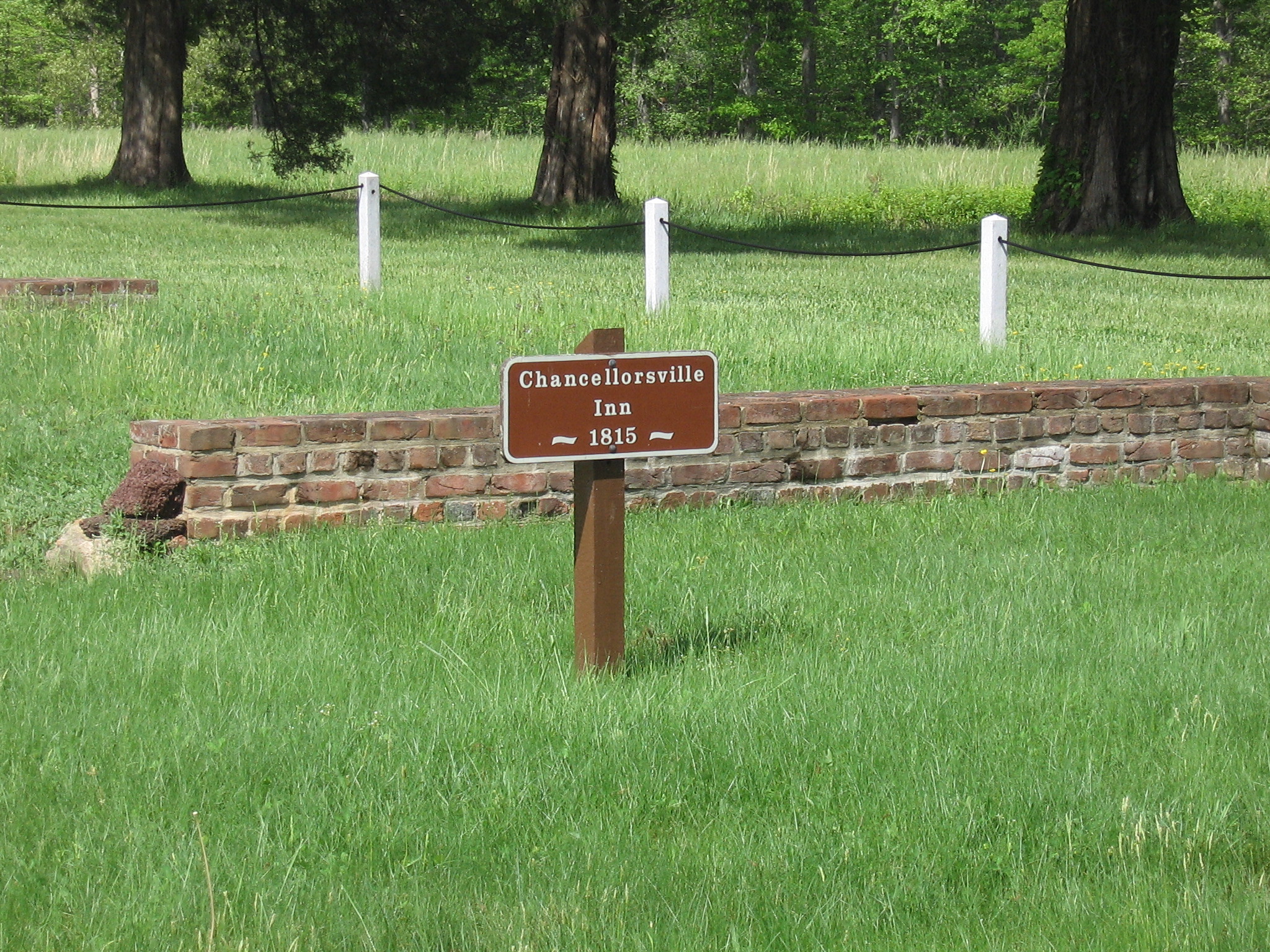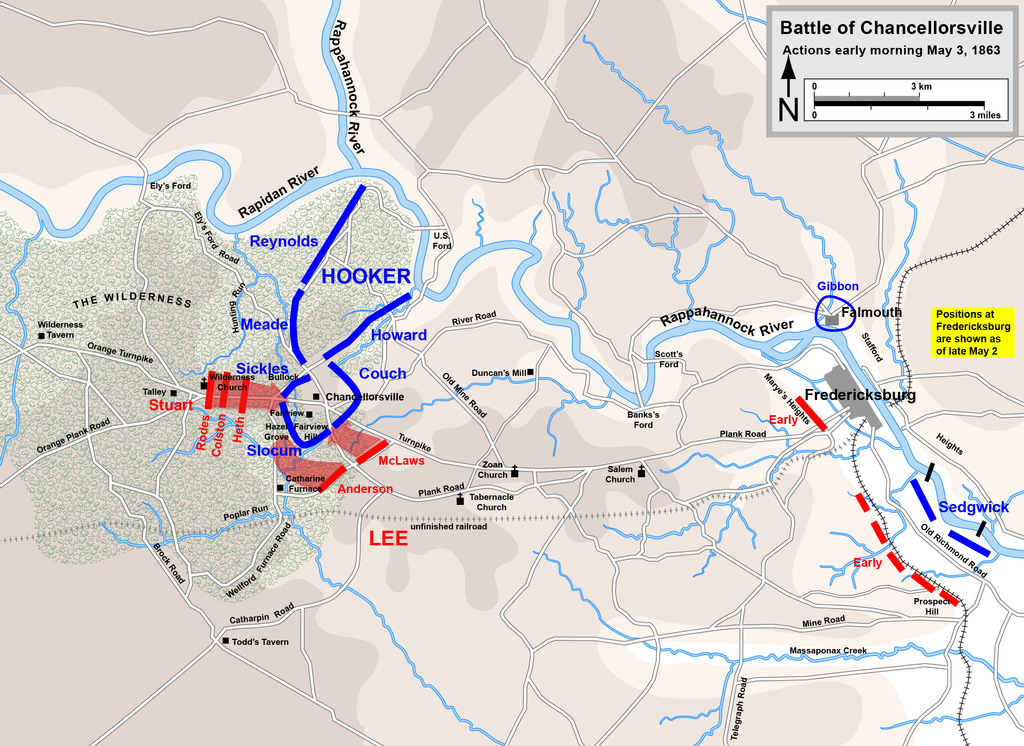The Fall of the Chancellorsville Crossroads
 The following is a chapter excerpt from “That Furious Struggle: Chancellorsville and the High Tide of the Confederacy, May 1-4, 1863,” authored by Chris Mackowski and Kristopher D. White. The Chancellor House site will be one of the stops on the upcoming Emerging Civil War tour of the Chancellorsville Battlefield, which is part of the Second Annual Emerging Civil War Symposium at Stevenson Ridge, August 7-9.
The following is a chapter excerpt from “That Furious Struggle: Chancellorsville and the High Tide of the Confederacy, May 1-4, 1863,” authored by Chris Mackowski and Kristopher D. White. The Chancellor House site will be one of the stops on the upcoming Emerging Civil War tour of the Chancellorsville Battlefield, which is part of the Second Annual Emerging Civil War Symposium at Stevenson Ridge, August 7-9.
***************
Days earlier, Joe Hooker had proclaimed that his plans were perfect. Now, as he stood on the front porch of the Chancellor house on the morning of May 3, those perfect plans were unraveling before his eyes.
He’d spent much of the morning riding his lines, urging on his men, keeping up their spirits, showing everyone why he’d earned the nickname “Fighting Joe.” Union soldiers responded with grim enthusiasm, matching charge with countercharge and going toe-to-toe with the Confederate army in what would become the bloodiest morning of the entire war and the second-bloodiest single day second only to Antietam. “[B]ullets . . . fell like rain drops in a summer shower,” one soldier wrote.
Withdrawing the III Corps from Hazel Grove and into a tighter defensive position had, Hooker thought, been a sound military decision. “The position I abandoned was one that I had held at a disadvantage,” he would say, after the war, as way of explanation.
But from the front porch, as Hooker watched Confederate artillery perched on Hazel Grove trade blows with his own artillery at Fairview and in the clearing around the Chancellor house, he began to realize the tide of battle had begun to shift against him. Confederate artillery that would never have otherwise come into play because of the thick woods had a perfect platform from which to bombard the Union position.
A courier rode up to Hooker with a dispatch.
Just as the general reached for it, a Confederate shell screamed toward them and slammed into the wooden column next to Hooker, sending splinters everywhere. A huge chuck of the column smashed into the general, knocking him to the porch floor, senseless.
Witnesses thought Hooker was dead. He lay unconscious for more than half an hour, and even after he revived, he was insensible. At one point, he tried to mount his horse so he could show his troops he was okay, but the attempt made him sick. Hooker’s doctor convinced the general to lie down on a blanket, and eventually, he evacuated the general to the rear, to a position near the Bullock farm. A few moments after Hooker left, a Confederate shell struck the blanket where the commander had been resting. “For the remainder of the day he was wandering, and was unable to get any ideas into his head,” wrote a member of Hooker’s staff.
The doctor declared that Hooker had a severe concussion. He “suffered great pain and was in a comatose condition for most of the time,” said a Union general. “His mind was not clear, and they had to wake him up to communicate with him.” Despite his injury, Hooker refused to turn over command to II Corps commander Darius Couch.
And so, for nearly an hour—as the tide shifted against the Union army, as Stuart and Lee reunited their forces and attacked all along the line, as Union guns withdrew from Fairview because they’d run out of ammunition—the Army of the Potomac suffered from a lack of leadership.
As the Union position at Fairview collapsed, Porter Alexander moved several of his artillery pieces forward from Hazel Grove to take up position where the Federal guns had been just moments earlier. “We deployed on the plateau, & opened on the fugitives, infantry, artillery, wagons—everything—swarming about the Chancellorsville house, & down the broad road leading thence to the river,” Porter later wrote.
During the barrage, the Chancellor house caught fire. Members of the Chancellor family and several neighbors, all huddled in the basement, were told by a member of Hooker’s staff that they had to flee. Winfield Scott Hancock directed Capt. Thomas Henry of the 140th Pennsylvania to assist in the evacuation of the house. Henry directed his company into the east wing of the mansion where they extracted 33 wounded soldiers and three women. According to Henry, the three women came out with him, one on each arm, with a third being towed by his coat tails. Other fugitives bolted from the house, through the roar of battle, to find safety. “The woods around the house were a sheet of fire—the air filled with shot and shell—horses were running, rearing and screaming—the men, a mass of confusion, moaning, cursing, and praying,” recalled one of the refugees. Hooker’s staff member took them up the road that led first to the Bullock farm and then beyond to U.S. Ford, where a chaplain then escorted them across the Rappahannock.

Artillery came on line in the yard and orchard of Chancellor home. Captain George F. Leppien’s 5th Maine Battery E blasted away at a relentlessly advancing line of Confederates. Leppien went down, as did 27 other gunners. By the end of the fight, there were two gunners at their pieces: John Chase and James Lebroke. A Confederate shell slammed into their gun, silencing it. Hancock ordered infantry to retrieve the cannon. Men of the 53rd, 116th, and 140th Pennsylvania Infantry regiments pulled the guns off the line; eventually, the 53rd and 140th turned their haul over to the 116th Pennsylvania of the Irish Brigade, which finished the job. Later, the 116th Pennsylvania erroneously received sole credit for saving the guns in Harper’s Weekly. Private John Chase, for his actions, was awarded the Medal of Honor.
Major General Darius Couch, Hooker’s secondin-command by virtue of seniority, led the final defense of the Chancellorsville intersection as the Union army tried to extract itself from the calamity that had befallen it. The Federals fought stubbornly even as they fell back to a new line established by Meade’s V Corps, with its apex across the road from the Bullock farm. Meade had urged Hooker to let him wade into the fray with his fresh corps as well as with the fresh I Corps—nearly 30,000 troops in all—but Hooker had held them back as insurance to stay any possible rout that might occur. The I and V Corps were Hooker’s last line of defense.
Lee, seeing that the Chancellorsville intersection now belonged in Confederate hands, rode down from Hazel Grove. When he arrived at the clearing around the house, his men parted to let him pass. “One long, unbroken cheer, in which the feeble cry of those who lay helpless on the earth blended with the strong voices of those who still fought, rose high above the roar of battle, and hailed the presence of the victorious chief,” wrote one of Lee’s aides-de-camp.
Sitting atop his white horse, Traveller, with the Chancellor mansion engulfed in flames behind him, Lee removed his hat and acknowledged his men. “He sat,” wrote Lee’s staffer, “in the full realization of all that soldiers dream of—triumph.”
